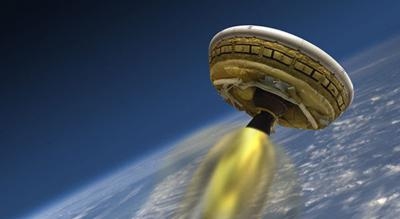Sat, Jun 14, 2014
NASA's 'Flying Saucer' Grounded Because Of Winds Aloft
NASA did not conduct the flight test of the agency's Low-Density Supersonic Decelerator (LDSD) from the U.S. Navy's Pacific Missile Range in Kauai, Hawaii, during its designated launch period. The project's reserved range time at the range will expire Saturday, June 14, with NASA unable to fly the test because of continuing unfavorable weather conditions.

Mark Adler, the Low Density Supersonic Decelerator project manager and Ian Clark, principal investigator on the project, both from NASA's Jet Propulsion Laboratory in Pasadena, California, participated in a media teleconference this morning and addressed questions on the project.
"There were six total opportunities to test the vehicle, and the delay of all six opportunities was caused by weather," said Adler. "We needed the mid-level winds between 15,000 and 60,000 feet to take the balloon away from the island. While there were a few days that were very close, none of the days had the proper wind conditions."
The team had researched for more than two years wind conditions and locations around the world that would be conducive to the test. Kauai was selected because research showed that this area had the proper wind conditions to carry the balloon away from populated areas and where it needed to go over the ocean in order to launch the test vehicle. Recent weather conditions have been unexpected and have caused unacceptable wind conditions to launch the balloon.
NASA continues to look at options for a future launch window. The team is working with the Pacific Missile Range Facility and looking at weather conditions predicted for later in the month when another launch window could be possible.
"Our team has been working on this project for several years, and we have been so focused," said Clark. "We came here to do our job and get this vehicle off the ground, but unfortunately weather didn't allow us to do this. We are very optimistic and are hoping to test the vehicle at the end of the month."
(Image provided by NASA)
More News
From 2023 (YouTube Version): Legacy of a Titan Robert (Bob) Anderson Hoover was a fighter pilot, test pilot, flight instructor, and air show superstar. More so, Bob Hoover was an i>[...]
Get The Latest in Aviation News NOW on Instagram Are you on Instagram yet? It's been around for a few years, quietly picking up traction mostly thanks to everybody's new obsession >[...]
Aero Linx: B-52H Stratofortress The B-52H Stratofortress is a long-range, heavy bomber that can perform a variety of missions. The bomber is capable of flying at high subsonic spee>[...]
Altimeter Setting The barometric pressure reading used to adjust a pressure altimeter for variations in existing atmospheric pressure or to the standard altimeter setting (29.92).>[...]
"Knowing that we play an active part in bettering people's lives is extremely rewarding. My team and I are very thankful for the opportunity to be here and to help in any way we ca>[...]
 Classic Aero-TV: Remembering Bob Hoover
Classic Aero-TV: Remembering Bob Hoover ANN FAQ: Follow Us On Instagram!
ANN FAQ: Follow Us On Instagram! ANN's Daily Aero-Linx (05.15.24)
ANN's Daily Aero-Linx (05.15.24) ANN's Daily Aero-Term (05.15.24):Altimeter Setting
ANN's Daily Aero-Term (05.15.24):Altimeter Setting Aero-News: Quote of the Day (05.16.24)
Aero-News: Quote of the Day (05.16.24)



